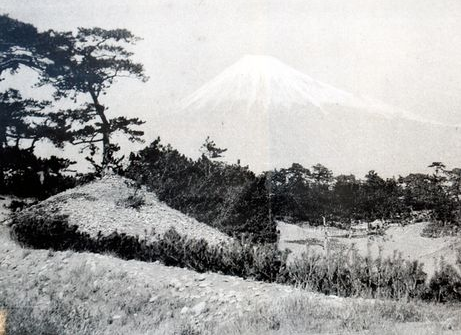Source - http://ajw.asahi.com/article/behind_news/social_affairs/AJ201601290004
 Suzukawa no Fujizuka, left, can be seen in this photo taken between the Meiji Era (1868-1912) and the Taisho Era (1912-1926). (Provided by the Fuji city government)
Suzukawa no Fujizuka, left, can be seen in this photo taken between the Meiji Era (1868-1912) and the Taisho Era (1912-1926). (Provided by the Fuji city government)
Local officials here confirmed that a famed "fujizuka" (mound representing Mount Fuji) dates to at least the 18th century.
Located near Tagonoura beach in the Suzukawanishi-cho district in the city, Suzukawa no Fujizuka was originally considered for nomination as a UNESCO World Heritage site, but the plan was eventually dropped because little was known about the history and origins of the site. Mount Fuji was inscribed on the World Heritage list in 2013.
The Fuji city government began excavating the 4.5-meter-high mound in December. Measuring 15 meters in diameter, the mound site contained fragments of Hizen ceramics, as well as stones from the nearby shoreline.
 A Fuji city official on Dec. 22 explains to local residents about the interim results of a survey of the Suzukawa no Fujizuka mound in the Shizuoka Prefecture city. The study is being conducted by removing the concrete cover on the mound. (Masashi Rokubuichi)
A Fuji city official on Dec. 22 explains to local residents about the interim results of a survey of the Suzukawa no Fujizuka mound in the Shizuoka Prefecture city. The study is being conducted by removing the concrete cover on the mound. (Masashi Rokubuichi)
While the stones appear to have been piled up on the mound to show respect for Mount Fuji, the officials expect the potsherds to date to the 18th century. An interim report on the discovery was released Dec. 22.
It was believed that the mound was constructed in the middle of the Edo Period or earlier as an inscription on a stone lantern in front of the monument reads “the second year of the Kyoho era” (1717).
The latest discovery of the broken Hizen ceramics supports the hypothesis.
Fujizuka are miniature versions of Mount Fuji that were created by “fujiko” religious groups that honor the nation's highest peak by worshipping it from afar. Fujizuka can be found in Tokyo and elsewhere.
Suzukawa no Fujizuka was created before the fujiko craze took off during the Edo Period (1603-1867).
According to local records from the era, such as “Surugaki,” mountain ascetics and others purified their bodies along the seashore in preparation for climbing Mount Fuji, and put stones that they found near the ocean on the top of Suzukawa no Fujizuka to pray for safety.
During the recent excavation, many flat stones worn by ocean waves were discovered.
The monument is on the grounds of Fuji Rokusho Sengenjinja shrine. The surface of the fujizuka was covered with concrete by the Suzukawa district administration committee, which is responsible for the management of the shrine site, in 1976 to prevent it from collapsing.
However, as an increasing number of people have come to visit Suzukawa no Fujizuka after Mount Fuji was included on the World Heritage list, the committee plans to remove the concrete cover on top so that those who climb it can pile seaside stones as a sign of respect.
The administration committee asked the Fuji city government to survey the mound--an essential step to removing the concrete cover.
On Dec. 22, committee members and local residents came to hear the interim results of the study.
“A closer examination is required before making a conclusion about the findings,” said an official of the city’s culture promotion division.